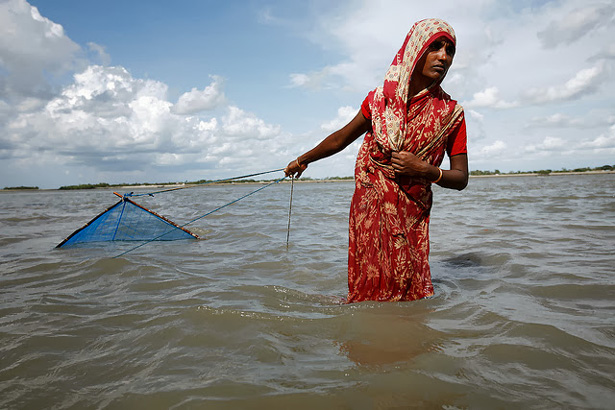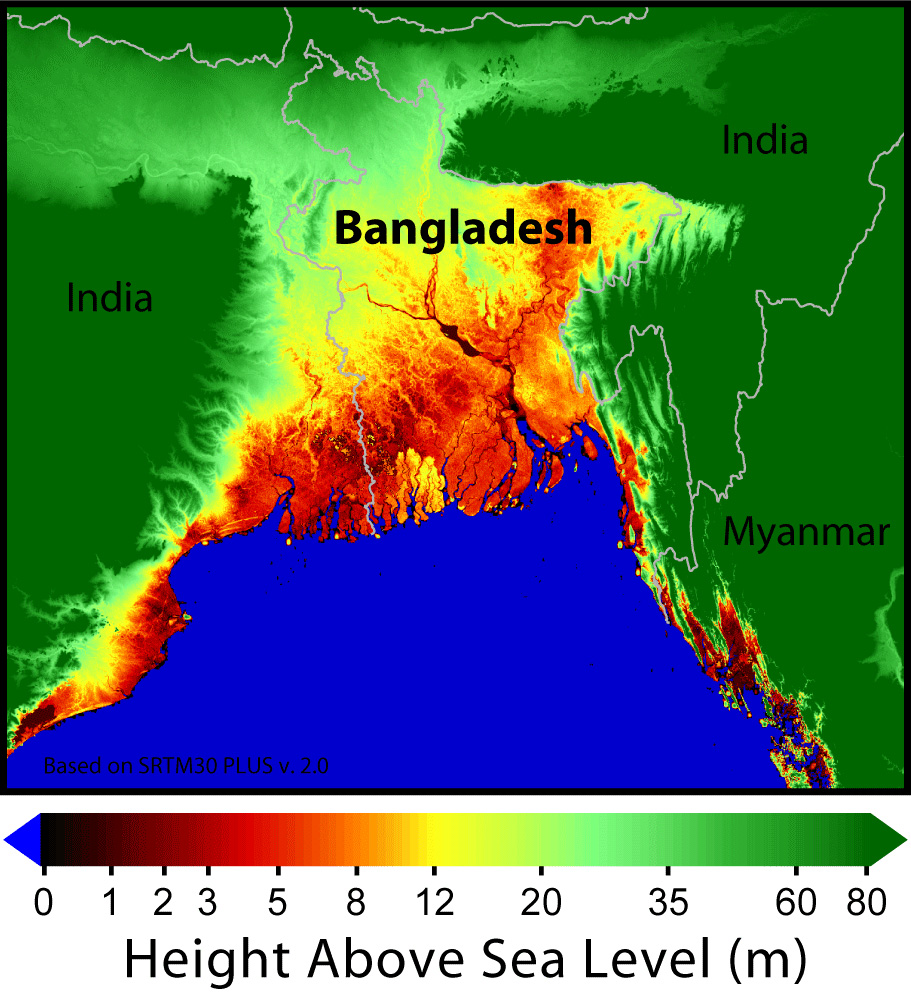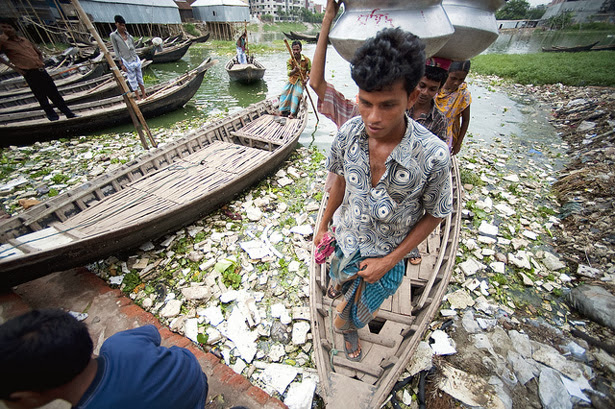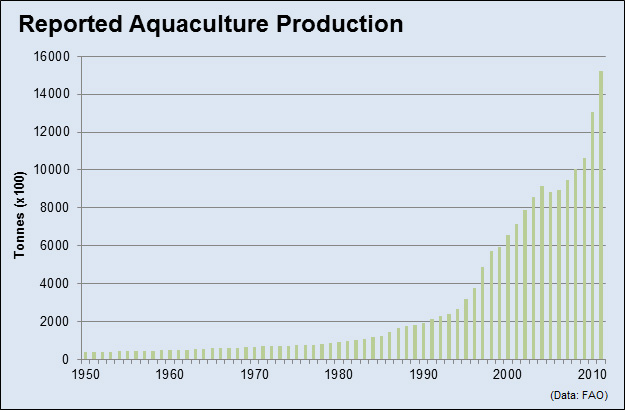-
Amid Perfect Storm of Climate Challenges, Can Aquaculture Net Food Security Gains in Bangladesh?
October 15, 2013 By Jacob Glass
It is difficult to find a country feeling the negative impacts of climate change more severely than Bangladesh. Name any alarming, seemingly far off effect of a warming world being discussed in the halls of Washington or the summits of Copenhagen, and there is a good chance Bangladesh is experiencing it today. Flooding, drought, sea level rise, mass migration, and crushing poverty are exacerbated by a growing population and rapid urbanization. This perfect storm of climactic and demographic trends presents a looming crisis for Bangladesh, no more so than when it comes to food security.
Yet travelling through the country – as I did in 2011 as a student at Muhlenberg College – one notices a change. Bangladeshis are harvesting carp and tilapia from ponds where rice fields, spoiled by salinization, once stood. But is the new trend of aquaculture enough to off-set the challenges of a changing climate in one of the most densely populated countries on Earth?
Flooding and Drought Disrupt Rice Production
For the last thousand years or so, rice has dominated the Bangladeshi diet. Accounting for 77 percent of agricultural land use and 70 percent of caloric intake, the food security of the country’s 151 million people is intimately tied to the thrice-annual rice harvests. However, the effects of climate change have begun to destabilize this long-time staple, reducing the industry’s capacity to keep pace with the demands of a swelling population.
Situated at the terminal flood plain delta of the Ganges, Brahmaputra, and Meghna Rivers, Bangladesh’s low-lying geography means that every year between 20 to 40 percent of the country is flooded. Though this annual flooding is the norm and once benefited rice farming by bringing nutrient-rich sediment down from the mountains, the frequency and intensity of recent floods has overwhelmed many farmlands.
 From the Himalayas, where UN experts say 95 percent of ice flows are in retreat, glacial melt has inundated the country in the north. “The river burst its banks,” a Bangladeshi woman told The Guardian earlier this year, recounting the aftermath of three successive floods between July and September 2012. “My rice paddy was washed away, even the very smallest plant. We would have been harvesting it next month.”
From the Himalayas, where UN experts say 95 percent of ice flows are in retreat, glacial melt has inundated the country in the north. “The river burst its banks,” a Bangladeshi woman told The Guardian earlier this year, recounting the aftermath of three successive floods between July and September 2012. “My rice paddy was washed away, even the very smallest plant. We would have been harvesting it next month.”Sea level rise in the Bay of Bengal also brings flooding from the south. Two-thirds of Bangladesh is less than five meters above sea level, making it exceedingly vulnerable to small ocean changes. Assuming global emissions continue to increase, the IPCC projects sea levels to rise by an average of 62 centimeters by the end of the century, an increase that could result in the loss of nearly 40 percent of productive land in the south, the country’s former breadbasket. Already, saline intrusion – a byproduct of coastal flooding that decreases soil fertility – has left between 29 and 36 percent of Bangladesh’s coastal belt “very strongly saline.”
In an ill-fated twist of irony, shifting weather patterns have also left the country more drought prone, particularly in the west. In 2010, agriculture was devastated after the lowest recorded rainfall since 1995. Researchers predict the recurrence of slight drought over the next 40 years could cause a 10 to 30 percent loss in rice yields, and severe drought a stunning 70 to 90 percent loss.
This is not to say all future rice production has been deemed hopeless. Far from it, Saleemul Huq, a Bangladeshi senior fellow at the International Institute for Environment and Development and a lead author of the IPCC’s third and fourth assessment reports, told me. Huq explains that the country’s scientists are developing salt-tolerant and high yield rice varieties to increase crop resilience, and rice will remain the staple food.
But despite these innovations, it’s clear Bangladesh must decrease its dependency on any one crop. To improve the country’s food security, “the basic strategy has to be diversification,” Huq says.
Density and Urbanization Exacerbate Scarcity
Though one of the most densely populated countries in the world, Bangladesh’s population story is actually one of success. Between 1989 and 2011, alongside significant decreases in infant and child mortality, the total fertility rate (average number of children per woman) declined precipitously from 5.1 to 2.3, thanks to strong efforts by the government and other organizations to increase access to contraceptives and health clinics. The country’s large population still has a great deal of demographic momentum, however, meaning that even decreased growth rates produce a substantial increase in people.

In 2012, the United Nations Population Division increased its projections for Bangladesh by almost four percent, predicting the country’s population will reach more than 200 million by 2050 – all in an area about the size of Alabama. With recent data showing that 25 million people are undernourished and 16 percent of the population has signs of acute malnutrition, the already stressed agricultural sector threatens to be overwhelmed.
Further exacerbating the food security crisis is the relocation of Bangladesh’s traditionally rural population to urban centers. Today 27 percent of Bangladeshis live in cities, a 7.5 percent increase from 1980. Dhaka, the capital, is one of the world’s fastest growing megacities, with a projected population of 22.9 million by 2025.
This wave of urbanization is leading to the physical expansion of cities and infrastructure onto arable land. According to one study, nearly 69,000 hectares of Bangladesh’s agricultural lands are being converted into new roads and residential areas annually, further undermining farmers’ abilities to increase production rates in accordance with growing demand.
Of particular note is the cyclical relationship between climate-induced urbanization and food insecurity. As flooding, saline intrusion, and other environmental stressors threaten agriculture-based livelihoods and displace rural Bangladeshis, urban centers expand, claiming still more farm land.
Fishing for Food Security
As the prospects for ever-increasing rice yields have become less viable, aquaculture has grown quickly to become the second-most valuable food source in Bangladesh. According to Gulam Hussain, former director general of the Bangladesh Fisheries Research Institute, farmed tilapia production increased from 4,000 to 138,000 metric tons between 2002 and 2012. By 2015, production is expected to reach 150,000 metric tons. New estimates show that at least 1.39 million tons of fish are produced each year, a 27 percent increase over 2011 official statistics.
Aquaculture in Bangladesh can be divided into two sub-categories. The first – fin fish farming, such as carp, tilapia, and pangasius catfish – is conducted primarily by family operations. Small-scale farms of this type allow poor and unskilled workers the opportunity to reach subsistence levels and beyond on a consistent basis.
In contrast, large-scale shrimp and prawn cultures in the south and southwest have emerged as a valuable export product, garnering $412 million in 2010 to become Bangladesh’s second biggest export. In these coastal areas, former rice farmers have converted land made brackish by rising seas into shrimp farms. Such adaptive strategies are helping to make up for declining rice growth and provide second-chance opportunities for out-of-work rice farmers. Aquaculture has also been integrated with traditional farming in some places to create “blue-green” systems where fish waste is used to enhance soil fertility, control pests, and boost crop production.
Responding to the adaptive potential of fish farming, both national and international organizations are implementing initiatives to further develop the industry. For example, USAID’s Feed the Future Aquaculture Project aims to infuse more than $200 million into the sector by 2016, improving the livelihoods of more than one million households across 20 districts. The project’s key goals are to train poor families to operate subsistence fish farms, stimulate commercial-level expansion, and improve the institutional capacity of the government to support the sector.
Development experts are also working to increase the climate resilience of the young industry. One project, co-sponsored by the UN Food and Agriculture Organization and the Bangladesh Department of Fisheries, promotes salt-tolerant coastal aquaculture and improves flood preparedness in shrimp farming operations. By implementing these and other adaptive mechanisms – such as nets and the introduction of more durable fish species (tilapia, carp) – the hope is that aquaculture can be positioned to weather the variable environmental conditions and storm surges that threaten traditional rice farming.
Unintended Consequences?
While many experts have lauded Bangladesh’s growing aquaculture sector as an innovative response to changing conditions, others have questioned the industry’s environmental integrity.
 According to Huq, rather than limiting development to areas already affected by salinity, new shrimp ponds are sometimes created by flooding uncompromised farmland with saltwater. Research has shown that without proper water management, shrimp farming can increase soil salinity and undermine the fertility of nearby rice farms, exacerbating one of the principle challenges stunting food production to begin with.
According to Huq, rather than limiting development to areas already affected by salinity, new shrimp ponds are sometimes created by flooding uncompromised farmland with saltwater. Research has shown that without proper water management, shrimp farming can increase soil salinity and undermine the fertility of nearby rice farms, exacerbating one of the principle challenges stunting food production to begin with.Due to the high value of shrimp, there are also questions of social equity. “The owners of these large farms tend to be rich people coming from the city,” says Huq. “They don’t actually generate employment locally.” Instead, the poor are left with declining soil quality, hunger, and rising tempers, which has resulted in violent clashes between locals and farm owners.
Another common critique is the risk of alien species release, which can – as with the African Catfish in India – result in the introduction of fish that out-compete native species and adversely affect biodiversity and ecosystem health.
Resilience, Not Vulnerability
As Bangladesh struggles to adapt to its impressive list of human and environmental challenges, aquaculture has emerged as perhaps the country’s best opportunity to diversify food production and adapt to climate changes. Yet with opportunity comes risk. Will Bangladeshis be able to harness aquaculture as a tool for sustainable development and climate adaptation? Or will unintended social and environmental byproducts undermine, rather than bolster, their ability to respond to future challenges?
Though a daunting undertaking, Huq urged faith in the Bangladeshi people, who he predicts will one day tackle the climate problems of the world. “Climate change solutions will come from here because this is where the problem is, and this is where the problem is being solved,” he says.
“We are not sitting idle. We are fighting. We are coming up with solutions. That’s the story here – the resilience, not the vulnerability. Bangladeshis are vulnerable, but they are also extremely resilient, and that resilience is what will help us tackle these adverse conditions that climate change is bringing to us and overcome them in the long run.”
Sources: Bangladesh Center for Advanced Studies, The Carbon Brief, Dhaka Tribune, The Fish Site, Food and Agriculture Organization, The Guardian, Humanitarian News and Analysis, International Rice Research Institute, Journal of Threatened Taxa, Sustaining Ethical Aquaculture Trade, UN Population Division, U.S. Agency for International Development, The World Bank, WorldFish Center.
Photo Credit: “Bangladesh Shrimp Fry Collection,” courtesy of Oxfam International; Map: “Sea Level Risks in Bangladesh,” courtesy of Resources for the Future; Photo: “Contaminated Waters in Bangladesh Slum,” courtesy of Kibae Park/UN Photo; Chart: “Reported Aquaculture Production,” courtesy of FAO; Map: “Salinity Concentration in Water,” courtesy of the Government of Bangladesh.
Topics: adaptation, agriculture, Asia, Bangladesh, biodiversity, climate change, conflict, consumption, demography, development, environment, environmental health, environmental security, featured, Feed the Future, flooding, food security, land, livelihoods, migration, natural resources, population, poverty, risk and resilience, UN, urbanization, USAID, water
 A Publication of the Stimson Center.
A Publication of the Stimson Center.







